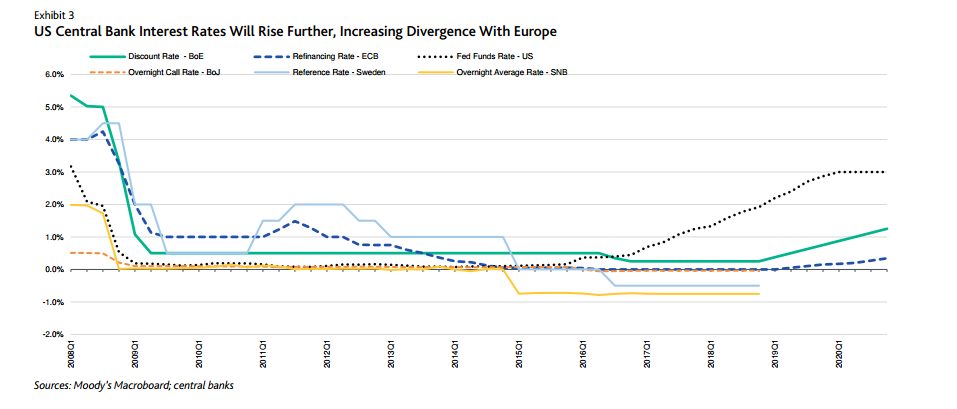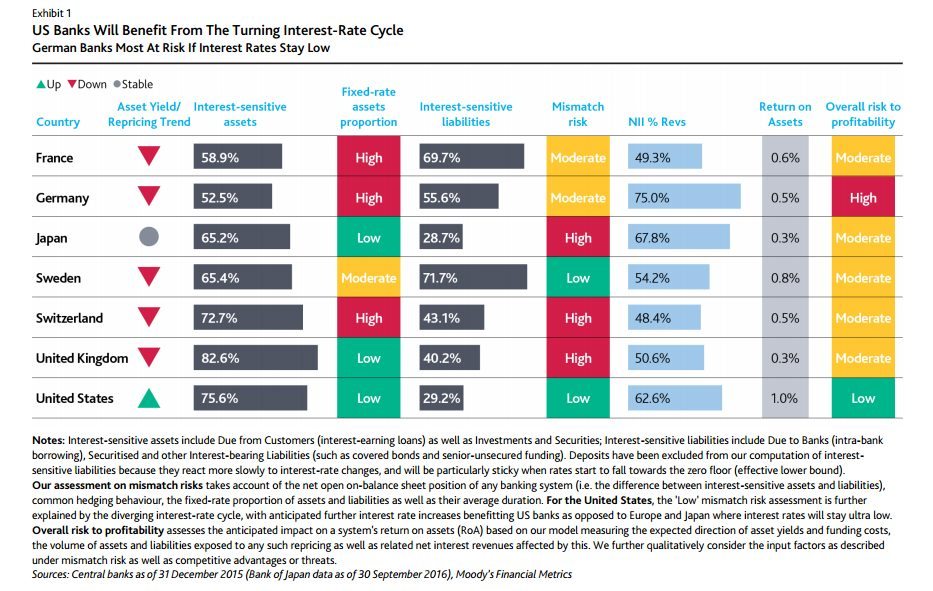Despite improving economic conditions in Europe, regional EU banks along with their Japanese counterparts are expected to lag the profitability of their US competition, a Moody’s report predicts. In part, the analysis may point to a nuanced relative value trade, but also highlights the impact negative rate policy has in yield sensitive industries – and how the impact can be initially cushioned but ultimately there is a point where the market catches up.

Negative rate policy is impacting banks on a regional and size basis
Negative Rate Policy will hurt EU and Japanese banks, while US banks could see profits as rates rise
When interest rates in Europe initially went negative, there was a cushion that protected regional bank interests from significant revenue decline.
“European banks have so far largely been able to shield their profits from the ultra-low interest rates that have prevailed since the financial crisis,” the June 1 Moody’s report observed. This was due to reduced interest payments on short-term deposit obligations that offset falling yields.
But this might not last.
“As long-term loans and other assets continue to reprice downwards, and with less headroom to further cut the rates they pay on their funding, pressures on profitability will grow.”
This can be observed in the bank’s high share of net interest income as a percentage of their revenues and a low share of interest-sensitive capital market funding.
The moves are expected to impact banking firms differently, with small, regional bank interests in Germany and Switzerland most at risk, highlighting fragmentation of investing opportunity.
The most venerable financial firms across the negative interest rate array break down based on three primary performance drivers.
European or Japanese bank interests with high exposure to net interest income as a percentage of total revenues are at risk along with those who have a dependence on consumer deposits to fund lending. In other words, smaller community banks not engaged in trading or global business deals. This along with those firms who have large exposure to longer-term fixed-rate assets, such as home mortgages, are also more at risk.
Banks that are likely to weather the storm are those with diverse business models and a high share of interest-sensitive market funding where their funding costs drop with interest rates.

Negative interest rate policy will impact banks regionally
If Negative Rate Policy suddenly reverses, certain financial firms will benefit from increased rates but a “shock” might occur
While bank profitability in a negative interest rate environment is, likewise, negative for such bank interests, reversing the situation could inflict pain on equity investors.
If interest rates were to sharply mean revert, this “could create short-term shocks,” but the European institutions hurting from interest rate pain might gain on certain debt holdings in such an environment.
There will come a point when the negative interest rate experiment in Europe will have to end. When that happens, Moody’s models a scenario where banks most exposed to long-term fixed-rate assets such as mortgages and other products they sold sensitive to short-term interest rates moves may, likewise, “face a profit shock.”
The profit shock will come as funding costs will increase much more rapidly than lending rates. “We expect Germany’s savings and co-operative banks, and to a lesser extent France’s mutualist groups and Switzerland’s cantonal and regional banks to be most vulnerable,” Moody’s noted.
The problems might extend into the Pacific Ocean as well.
The report pointed out Japan is already close to the lower bound for funding costs due to Japanese banks repricing deposits down to zero interest, while market-related funding “is not going lower from here.”
Contrast this to the US, where rates are already trending higher and stock markets have been climbing. “Given the high exposure of most US banks to largely variable-rate assets as well as the high share of revenues generated from net interest income (63%), we believe US banks are well positioned to deliver improving profitability over the next 12 to 18 months.”
